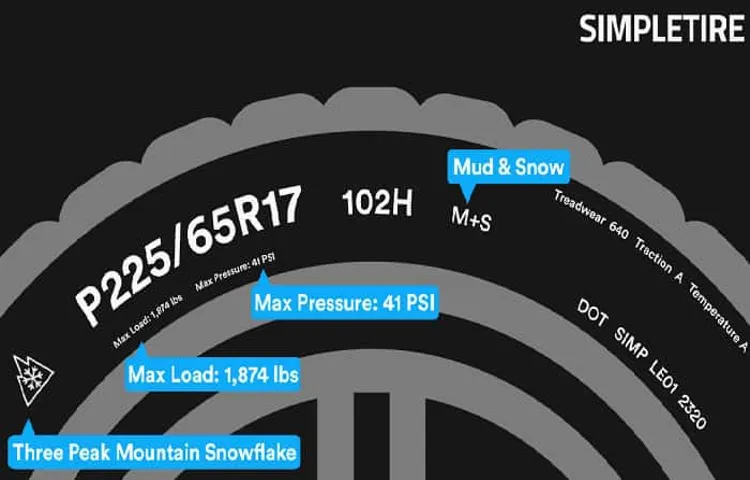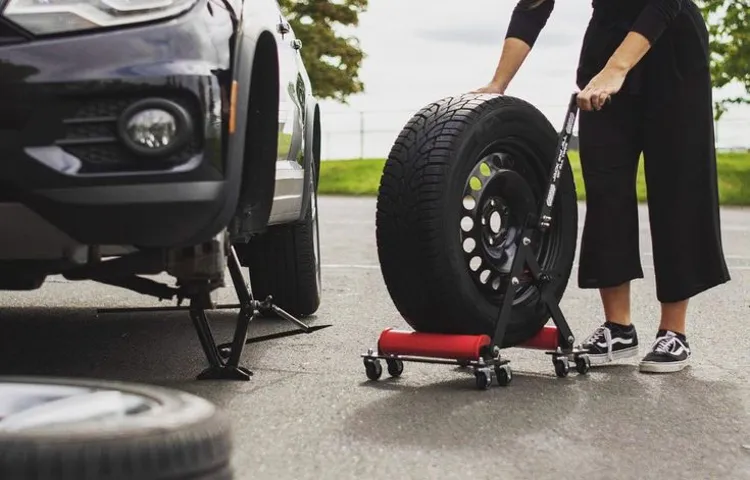Have you ever been driving down the road and suddenly gotten a flat tire? It’s a frustrating experience that can slow down your day and potentially leave you stranded on the side of the road. That’s why having a spare tire is so important, but do you know how much PSI is in your spare tire? It’s a question that often goes overlooked, but one that can make all the difference in an emergency. In this blog, we’ll dive into the topic of spare tire pressure and why it’s crucial to check it regularly.
So buckle up and let’s get started!
Table of Contents
Understanding Spare Tires
When it comes to spare tires, many people are unaware of the importance of maintaining them properly. One thing to keep in mind is the importance of checking the air pressure in your spare tire. A common question people ask is, “how much psi should be in a spare tire?” Generally, the recommended psi for a spare tire is around 60 pounds per square inch (psi).
However, it’s always best to consult your vehicle’s owner manual to be sure. The reason it’s essential to maintain the proper air pressure in your spare tire is that an underinflated tire may not be able to support the weight of your vehicle, leading to accidents or collisions. Therefore, it’s wise to inspect your spare tire’s air pressure monthly or before embarking on a long journey.
Don’t forget about your spare tire; remember, it could be the lifesaver you need in an emergency.
Types of Spare Tires
Understanding Spare Tires – Types of Spare Tires Spare tires are an essential part of any vehicle, serving as a backup when the original tire goes flat. However, not all spare tires are the same. There are three main types of spare tires: full-size, temporary, and run-flat.
Full-size spare tires are identical to the original tire and are designed to fit in the wheel well of the car. They offer the best performance and handling but take up a lot of space. Temporary spare tires, also known as “donuts,” are smaller and lighter than full-size spares and are designed for short-term use only.
They are meant to get you to the nearest tire shop or home and are limited in speed and distance. Lastly, run-flat tires are designed to allow you to continue driving even if the tire is completely deflated. They offer the most convenience, as you don’t have to change the tire immediately and can continue driving up to 50 miles.
However, they are expensive and have a stiffer ride. Understanding the type of spare tire you have and its limitations can help you better prepare for unexpected tire issues on the road.

Manufacturer Recommendations
Understanding spare tires is crucial for every driver as it could come in handy during emergencies. First, it is essential to note that spare tires come in different types, including full-size, mini, donut, and collapsible. Therefore, it is paramount to understand the manufacturer’s recommendation on the kind of spare tire suitable for your vehicle.
The type of spare tire to choose should be based on various factors, such as the type of vehicle, the weight of the car, and the distance necessary to travel on the spare tire. For instance, a full-size spare tire is ideal for trucks, SUVs, and larger cars as they can accommodate the tire’s weight. Conversely, a donut or mini spare tire is suitable for smaller and lightweight cars as they are designed to fit in the trunk, leaving enough space for other essentials.
Therefore, before purchasing a spare tire, it is vital to research which type is recommended by the manufacturer based on the make, model, and year of your vehicle.
Finding the PSI for Your Spare Tire
If you’re ever in need of using your spare tire, it’s important to know how much PSI it requires. The PSI, or pounds per square inch, can vary depending on the type of vehicle you have and the size of your spare tire. The recommended PSI for your spare tire can typically be found in your vehicle’s owner manual or on a sticker located on the inside of your car door or glove compartment.
It’s important to note that the spare tire is not meant to be a permanent replacement for your regular tires and should only be used as a temporary solution. Checking the PSI of your spare tire regularly can ensure that it’s ready to use in case of an emergency. So, always make sure to have a reliable tire gauge on hand to check the psi in your spare tire and ensure your safety on the road.
Checking the Tire Sidewall
When it comes to checking the tire pressure of your spare tire, it is important to refer to the sidewall of the tire for the recommended PSI (pounds per square inch). The PSI for a spare tire can vary depending on the make and model of your vehicle, so it’s crucial to find the correct number to ensure your safety while driving. To find the recommended PSI, look for the information stamped onto the tire’s sidewall, which includes the tire size, the maximum load, and the maximum air pressure.
The recommended PSI for your spare tire may be different than the PSI for your regular tires, so be sure to find the accurate information before inflating your spare tire. Neglecting to check the tire pressure of your spare tire can lead to potential safety hazards, so make sure you are taking the necessary precautions to keep yourself and your loved ones safe on the road.
Consulting Your Vehicle Manual
If you find yourself in the unfortunate situation of needing to use your spare tire, it’s important to remember that the PSI (pounds per square inch) may be different than your regular tires. To ensure your safety and the longevity of your spare tire, it’s important to consult your vehicle manual for the recommended PSI. The manual will provide you with the manufacturer’s recommendations for the spare tire, which may differ from your regular tires due to the size and type of spare tire.
It’s important to never exceed the recommended PSI, as over-inflating can lead to a blowout and under-inflating can cause poor handling and excess tire wear. Keeping your spare tire properly inflated will not only keep you safe on the road, but also ensure that it’s ready for use in case of an emergency.
Online Resources
If you find yourself with a flat tire, you’ll need to replace it with your spare. It’s important to know what PSI (pounds per square inch) your spare tire requires in order to ensure a safe and comfortable ride. Finding the PSI for your spare tire can be a bit tricky, but thankfully there are online resources that can help.
You can start by checking your car’s manual or by looking for a sticker on your tire that lists the recommended PSI. If you can’t find this information, you can use an online tire pressure calculator to determine the correct PSI for your spare tire. Simply enter your car’s make and model, along with the size of your spare tire, and the calculator will provide you with the recommended PSI.
With this information, you can inflate your spare tire to the proper pressure and hit the road with confidence. Remember, driving on an underinflated tire can be dangerous and can cause damage to your car, so always make sure your tires are properly inflated before hitting the road.
Inflation Tips for Spare Tires
When it comes to spare tires, it’s important to know how much PSI to inflate them to. Typically, the recommended PSI for a spare tire is around 60 PSI. However, it’s important to double-check the recommended PSI for your specific tire model, as it may vary.
It’s also important to note that spare tires are not meant for long-term use and should only be used temporarily until a proper tire replacement can be made. Additionally, you should always check the condition of your spare tire, including the tread and age, to ensure it is safe to use in case of an emergency. So, make sure to keep a close eye on your spare tire and don’t hesitate to replace it if necessary.
Inflating to Recommended PSI
Inflating your spare tire to the recommended PSI is an essential task that every driver should know. When you get a flat tire, you’ll need to replace it with your spare tire. Before you hit the road again, you’ll need to inflate your spare tire to the recommended PSI, which is typically found in your car’s owner manual.
Over-inflating your tire could result in a blowout, while under-inflating it could make your vehicle handle poorly and increase your fuel consumption. Therefore, it’s crucial to make sure your spare tire is inflated to the proper PSI. You can use a tire gauge to check your tire’s current pressure and add air if necessary.
Always double-check the recommended PSI for your spare tire before inflating it. You don’t want to be driving on a flat tire or losing control of your car due to improper tire inflation. Keep yourself and your passengers safe by giving your spare tire the attention it deserves.
Checking for Leaks or Damage
When it comes to taking care of your spare tire, it’s important to check for leaks or damage regularly. Inflation is a vital aspect of keeping your spare tire in optimal condition, but it’s not just a matter of adding air. It’s crucial to inspect the tire thoroughly for leaks or punctures before inflating it.
If you notice any damage, such as cracks or cuts, don’t try to inflate the tire as it could lead to further damage or even a blowout. Instead, take your spare tire to a professional and have them assess the situation. If you don’t find any visible damage, you can add air to your tire using a tire pressure gauge to ensure you’re inflating it to the recommended pressure level.
This step is critical in case you get stuck with a flat tire on the side of the road, and your spare tire is your only option. Remember to check your spare tire periodically, and don’t wait until an emergency occurs to realize it’s not in adequate condition.
Conclusion
In conclusion, the question of how much psi is in a spare tire is not a simple one. It depends on the make and model of the vehicle, as well as the size and type of the spare tire itself. But one thing’s for sure: whether you’re driving on four wheels or temporarily rolling on a spare, it’s always a good idea to keep an eye on your tire pressure.
After all, as the saying goes, a penny for your thoughts can become a dollar for your tire repair bill if you’re not careful!”
FAQs
What is a spare tire and why is it important?
A spare tire is an extra tire kept in a vehicle for emergency situations. It is important in case of a flat tire on the road.
What is the recommended PSI for a spare tire?
The recommended PSI for a spare tire can vary depending on the make and model of the vehicle, but it is typically between 60-80 PSI.
How often should I check the pressure in my spare tire?
It is recommended to check the pressure in your spare tire at least once a month, along with the rest of your tires.
Can I drive on my spare tire for long distances?
Spare tires are not meant for long-term use and are intended to be used as a temporary fix until a regular tire can be repaired or replaced.
Do I need to replace my spare tire?
If your spare tire is old or has been used before, it may need to be replaced even if it appears to be in good condition.
Can I use a different size spare tire on my vehicle?
It is not recommended to use a different size spare tire on your vehicle as it can potentially cause damage to your vehicle’s drivetrain.
How do I know if my spare tire is compatible with my vehicle?
The owner’s manual for your vehicle will provide information on the specific size and type of spare tire that is compatible with your vehicle.



